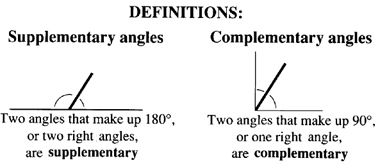

The resulting value will be the complement of the complementary angles. So, to find the complement of a complementary angle, one has to subtract the known value of the angle from 90. Since now we know what are complementary angles, can we notice a common point in the definitions we studied above? Right angle and 90 degrees! The entire concept of complementary angles revolves around the right angle. Can we still refer to them as complementary? Well, yes! Non-adjacent complementary angles do not have a common vertex but add up, making a right angle.įinding the complement of a Complementary Angle However, these angles do not have the same vertex. As can be seen, two angles, ABC and QPR, add up to 90 degrees and make a right angle. Let us understand non-adjacent complementary angles by a pictorial representation. Those angles whose vertex is not common and make up a right angle are non-adjacent complementary angles. Since we know about complementary angles, we can determine what non-adjacent complementary angles mean. Why a right angle? Because 70 + 20 = 90 degrees, a right angle! Since both the angles BOC and BOA have a common vertex O and both make a right angle, they are said to be adjacent complementary angles.

The angles joined with a common vertex/common arm or are a part of the same right angle are referred to as adjacent complementary angles.Ĭonsider the figure demonstrated below. Adjacent Complementary AnglesĪs the term adjacent denotes, these complementary angles must be near each other. What do you think? Are they always joined with each other? Two types of complementary angles are known in geometry: Non-adjacent and adjacent complementary angles. Some people may try to figure out whether complementary angles are always joined with each other or not. Are Complementary Angles always joined with each other? If it’s greater than 90, then? Need to wait for a little while when we jump to supplementary angles. If the angle is less than 90 degrees, we can say that the angle is complementary. We can measure the angles in a complementary angle with the help of a protractor.
SUPPLEMENTARY ANGLE VS COMPLEMENTARY HOW TO
After knowing the definition of the complementary angle, let us look at how to determine the complementary angles. How to Find Complementary Angles?Ĭan we determine which one is a complementary angle and which one is not? Not so easily.
SUPPLEMENTARY ANGLE VS COMPLEMENTARY PLUS
Mathematically, if angle BXC plus angle CXD is equal to 90 degrees, they are complementary. Speak like this: angle BXC complements angle CXD and vice versa. When these angles are considered separately, they are referred to as complementary angles.Īs a result, angle BXC and angle CXD are complementary angles or complement each other. On the right-hand side, angles BXC and CXD make a right angle when joined together. On the left side, the angle AXB is a right angle, i.e., the value of angle AXB is equal to 90 degrees. The former is incorrect, while the latter is correct.Ĭonsider the figure as shown. Many make mistakes and spell complementary instead of complimentary. Moreover, be careful while spelling the word.

How fascinating is that!Īccording to Merriam-Webster, the definition of complementary angles is two angles that add up to 90 degrees. That is not what we want, right? Yet, the look-up popularity in Merriam-Webster for complementary angles is top 7% of words. So it is clear why the right angle is known as a complete angle.ĭo you refer to Merriam-Webster while looking for any definition of an unknown word or phrase? For example, while looking for complementary angles, one will see complementary air and complementary cell. More fascinating though is, cutting a slice of bread into two triangles will yield two right angles having a pair of complementary angles. So, can we say a right angle is a complete angle? Think it over. The word complementary comes from a Latin word, completum, meaning completed. In other terms, angles making a right angle can be termed complementary angles. Complementary AnglesĬomplementary angles are those whose sum is equal to 90 degrees. So what exactly do complementary and supplementary angles mean? Let us understand more about them. Complementary Angles might be sounding like we are complementing an angle, right? But, no! The complementary angles definition is different when it is learned under Mathematics.


 0 kommentar(er)
0 kommentar(er)
